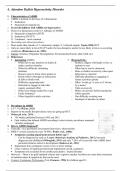Lecture notes
Lecture Notes BB I TB3 L4
- Institution
- The University Of York (UOY)
This is a well-rounded lecture summary of "Attention Deficit Hyperactivity Disorder” lecture in the Third Teaching Block in the Brain and Behaviour module, Year 1. The collection of notes form both the slides provided before the lecture and the actual lecture. It contains all the key points n...
[Show more]



